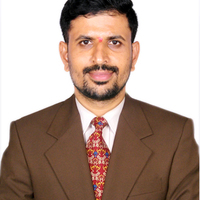- FACULTY OF ENGINEERING, MANAGEMENT AND TECHNOLOGY
DEPARTMENT OF COMPUTER SCIENCE AND ENGINEERING
BGS INSTITUTE OF TECHNOLOGY-ADICHUNCHANAGIRI UNIVERSIRTY
B.G.NAGARA
NAGAMANGALA TALUK
MANDYA DISTRICT-571448
KARNATAKA, INDIA - 8722296365
- Mr. Manu Y M received the B.E degree in Computer Science and Engineering, the M.Tech degree in Computer Science and Engineering and pursuing Ph.D. degree in Computer Science and Engineering. He is currently working as Assistant Professor, Department of Computer science and Engineering, BGS Institute of Technology-Adichunchanagiri University, Balagangadhar... moreMr. Manu Y M received the B.E degree in Computer Science and Engineering, the M.Tech degree in Computer Science and Engineering and pursuing Ph.D. degree in Computer Science and Engineering. He is currently working as Assistant Professor, Department of Computer science and Engineering, BGS Institute of Technology-Adichunchanagiri University, Balagangadharanatha Nagara. His research interests include Video analytics, Machine Learning, Data mining. He is Recipient of Award “In Recognition of Valuable Contributions in Academics and Co-curricular Activities of the Institution” award. He is Recipient of Award India Prime Quality Education Award, He is Recipient of Academic Excellence Award 2021; He is Recipient of Young Researcher Award. He is a member of Professional Bodies like ISTE, IEAE, IAENG, IEEE, the Indian Science Congress Association, Research Stars and ASR etc He has published 12 research papers in peer reviewed /Scopus/UGC listed international/national journals and has presented and participated in 25 international/national conferences. He attended various National and International Seminar, Conferences, Workshops, FDPs, training programs. He filed 07 patents He contributed as a reviewer for Various IEEE Conferences. He is the author of 2 Books. And He involved NSS Activities which were conducted by college towards rural development. And he is the member convener of college societal committee and this committee used to conduct rural development, rural school development activities.edit
Spurious(dishonourable) behaviour in drinking water utilization is a compelling problem facing water supplying companies and agencies. This behaviour results in a enormous loss of income and forms the highest percentage of non-technical... more
Spurious(dishonourable) behaviour in drinking water utilization is a compelling problem facing water supplying companies and agencies. This behaviour results in a enormous loss of income and forms the highest percentage of non-technical loss. Finding competent analysis for identifying spurious activities has been an active research area in recent years. Intelligent data mining techniques can service water supplying companies to detect these spurious activities to decrease such losses. This analysis explores the use of two distribution techniques (SVM and KNN) to identify suspicious cheat water customers. The main encouragement of this analysis is to benefit Yarmouk Water Company (YWC) in Irbid city of Jordan to affect its profit loss. The SVM based approach uses customer load profile characteristics to display anomalous behaviour that is well-known to be interacted with non-technical loss activities. The data has been collected from the ancient data of the company billing system. The efficiency of the developed model hit a rate of over 74% which is better than the present standard prediction steps taken by the YWC. To expand the model, a opinion tool has been built using the develop model. The system will help the company to predict careful water customers to be authorized on site.
Research Interests:
People's safety in a public place is very important and this can be attained with the help of anomaly detection. This paper presents an approach to automatically detect abnormal activities in crowded scene. In light of this, we are... more
People's safety in a public place is very important and this can be attained with the help of anomaly detection. This paper presents an approach to automatically detect abnormal activities in crowded scene. In light of this, we are developing a model in deep learning algorithms namely CNN and VGG16. We are collecting the anomaly and normal CCTV videos to build this project. Then we train with those videos with our algorithms to achieve best precision.
Research Interests:
The effective analysis and detection of crowd behavior is a very challenging issue in video surveillance systems. Most of the conventional approaches is not up to the mark for real time behavior analysis. In this work, an optical flow... more
The effective analysis and detection of crowd behavior is a very challenging issue in video surveillance systems. Most of the conventional approaches is not up to the mark for real time behavior analysis. In this work, an optical flow method along with KNCN classification approach is proposed to recognize and track abnormality in a video scene. Optical flow is an efficient global motion information algorithm. The optical flow vector provides direction and displacement of a point between two consecutive frames. This feature vector acts as input for the classification stage. A surrounding neighbor (SN) concept is used for finding k-nearest centroid neighbors (k-NCN) for each frame, where the class level is assigned based on the votes of k-NCN. The simulation results are promising and seems very efficient in terms of accuracy. The simulation results are analyzed and a frame level comparison with the ground truth is performed. ROC analysis provides area under curve (AUC) for different data sequences and is compared with other existing techniques; moreover, our proposed model KNCN-KADA obtained a promising accuracy of 99%. Keywords k-nearest centroid neighbors (k-NCN) • Point of interest (PoI) • Motion heat map (MHM) • Area under curve (AUC)
